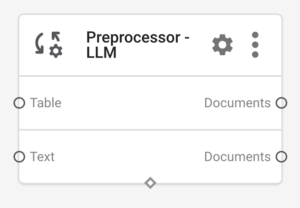An intelligent document preprocessing connector that uses Large Language Models to analyze and chunk documents into semantic segments optimized for vector embedding storage and enhanced searchability.

Key Capabilities
- Intelligent semantic chunking using LLM reasoning to maintain context boundaries
- Table-aware processing that preserves markdown table structure and row integrity
- Automatic document summarization with dedicated summary chunks for overview generation
- Token-aware splitting with configurable limits matching embedding model requirements
Configuration
Basic Configuration
- Model Selection: Connect any LLM connector via the invoke interface – supports OpenAI, Anthropic, local models, and custom LLM implementations
- numberOfTokens: Configure chunk size to match your embedding model (default 384 tokens)
- LLM Connection: Required minimum 1 LLM connection for document processing operations
Inputs and Outputs
Input Channels
- text: Raw text content, accumulated until document processing is complete, no size limit
- table: Markdown table content processed separately with row-boundary preservation
Output Channels
- documents: Array of Doc objects with DocMetadata including chunkId, objectId, nodeId, parent path, permissions, summary flags, and table indicators
Supported Model Variants
| Model Variant | Description | Max Tokens | Optimized for |
|---|---|---|---|
| Any LLM Connector | Uses invoke interface for universal LLM compatibility | Model-dependent | Document semantic analysis and intelligent chunking |
| OpenAI Models | GPT-3.5, GPT-4 variants via OpenAI connector | Model-dependent | High-quality semantic boundary detection |
| Local Models | Ollama, LlamaCpp, and custom local implementations | Model-dependent | Privacy-focused document processing |
Data Flow Process
- Text and table inputs accumulate in memory during document processing lifecycle
- LLM invoked with structured prompt containing chunking guidelines and token limits
- Response parsed as JSON containing chunks array with content and metadata flags
- Doc objects created with full metadata including chunkId sequence and summary indicators
- Documents emitted via writeDocuments() to connected downstream components
Common Use Cases
- Vector database preparation: Connect text sources → preprocessor:LLM → vector store connectors for RAG applications
- Document analysis pipeline: Wire document extractors → preprocessor:LLM → embedding connectors → search systems
- Content summarization: Use summary chunks from preprocessor:LLM output for document overview generation
- Table processing workflow: Connect structured data sources → preprocessor:LLM table input → document stores with table metadata
Frequently Asked Questions
Authentication Errors
- LLM invoke failures → Verify connected LLM connector configuration and API credentials
- Missing LLM connection → Ensure minimum 1 LLM connector is wired to invoke interface
Input Limitations
- Memory issues with large documents → Automatic hierarchical splitting by paragraphs, sentences, then words
- Token limit exceeded → Adjust numberOfTokens parameter to match connected LLM model limits
Response Issues
- Poor chunk quality → Verify LLM model supports structured JSON responses and reasoning
- Empty chunk arrays → Check input text contains chunkable content and LLM response format
